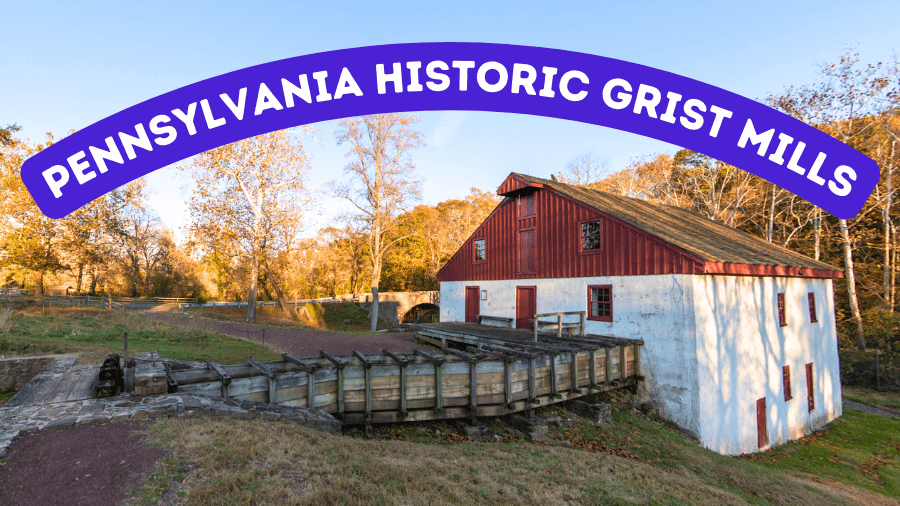If you’ve never geeked out over a giant wooden waterwheel or watched flour get made the old-school way, you’re in for a treat.
Pennsylvania is packed with historic grist mills that still grind, clank, and creak, just like they did in the 1700s!
This road trip hits the best ones across the state, from peaceful countryside mills with red barns to wild, waterfall-filled parks hiding century-old machinery.

You’ll explore places where George Washington once camped and walk inside buildings older than the United States.
Ready to hit the road and time travel one mill at a time? Let’s roll.
1. Thompson-Neely Grist Mill — Bucks County
Thompson-Neely Grist Mill, part of Washington Crossing Historic Park in Bucks County, was built in the 1870s, but its roots go back to the 18th century.
The mill was fully restored in recent years, and a new waterwheel was added in 2017.
Today, it occasionally opens for tours and demos, offering a peek into how grain was milled in the 1800s.
2. Newlin Grist Mill — Delaware County

Next up is the seriously cool Newlin Grist Mill in Glen Mills—it’s been standing strong since 1704 and is one of the oldest mills in the country.
The mill sits on a 160-acre park with hiking trails, a trout pond, and even a blacksmith shop, so there’s way more to explore than just the mill itself.
Inside, the preserved machinery shows how water once powered the milling process, giving you a close-up look at early industrial life.
3. Mill at Anselma — Chester County

Then there’s the Mill at Anselma in Chester Springs, which is like stepping into a time machine that takes you straight back to the 1700s.
Built in 1747, it’s one of the best-preserved colonial-era mills in the country, with original wooden machinery still powered by a waterwheel from Pickering Creek.
The best part? They still grind cornmeal and flour you can buy, so yes, you can take home a bag of history and make pancakes with it.
4. Mascot Roller Mills — Lancaster County
For something totally different, visit Mascot Roller Mills in Ronks, where the mill looks like it popped out of a postcard from Amish Country.
Built in 1737, the mill was updated in 1906 with steel rollers, belts, and pulleys still powered by water-driven turbines.
Right next door is the Ressler Family House, fully furnished like it’s still the early 1900s.
It gives you the chance to step into the everyday life of the folks who kept the mill running for generations.
5. Wallace-Cross Mill — York County
Wallace-Cross Mill in East Hopewell Township brings major old-school charm with its bright red walls and peaceful countryside setting.
Constructed in 1826 beside Rambo Run, this mill runs on a 1922 steel Fitz water wheel and still contains historic machinery from its early days.
The volunteers here love sharing stories and turning the wheels for live demos!
It’s a bit off the beaten path, but it’s worth the detour for peaceful vibes, great photos, and a whole lot of history in one cozy place.
6. Burnt Cabins Grist Mill — Fulton County

Way out in Fulton County, Burnt Cabins Grist Mill feels like a hidden gem straight off old Route 522, where the past is literally still grinding away.
This 1840 mill sits beside a cute campground and still produces flour the traditional way, powered by the steady flow of the nearby creek.
You can grab a bag of fresh stone-ground flour, explore the scenic grounds, and learn a bit about how the mill works.
If you’re staying the night, you’ll fall asleep to the sound of the creek that powers the whole thing.
7. McConnell’s Mill — Lawrence County

Last but definitely not least, McConnell’s Mill is located right in the middle of a jaw-dropping state park full of cliffs, waterfalls, and rocky hiking trails.
The original mill dates back to the 1800s and was rebuilt after a fire with a slick water turbine instead of a wheel—pretty high-tech for its day.
After checking out the grinding gear inside, take the nearby trail to see the covered bridge and the fast-moving Slippery Rock Creek.
Related Posts



